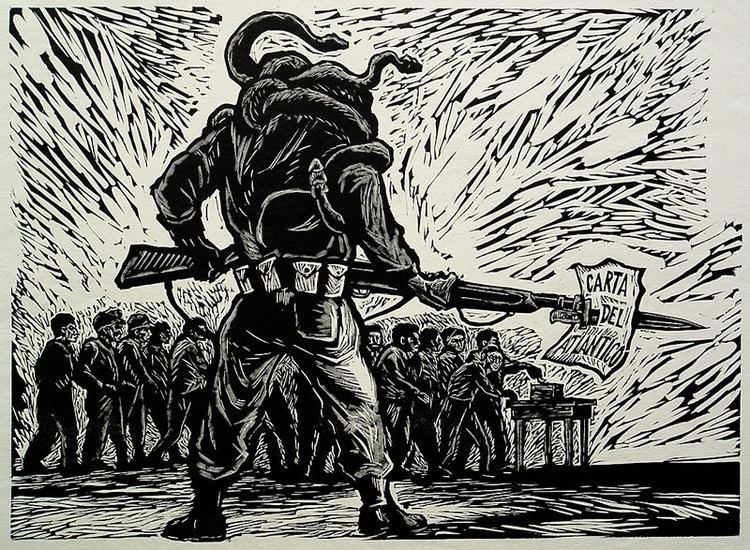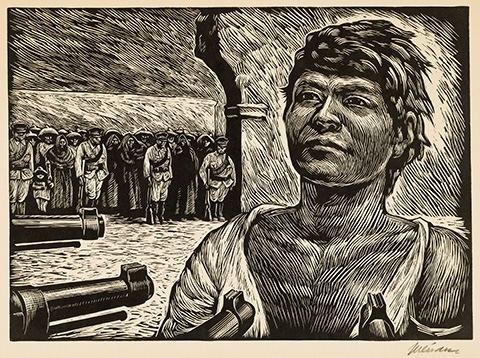 | ||
Members Roberto LazosAlfredo MerelesFrancisco Javier Calvo Sánchez (master printer)Julián Castruita MoránHèctor Vargas Past members Leopoldo MéndezLuis ArenalPablo O'HigginsJosé Chávez MoradoAlfredo ZalceÁngel BrachoFrancisco DosamantesEverardo RamírezAlberto BeltránFrancisco MoraJean CharlotRaúl AnguianoFanny RabelMariana YampolskyXavier GuerreroLeticia OcharánJesús Álvarez AmayaArturo García BustosAndrea GómezElizabeth CatlettAdolfo MexiacSarah JiménezJesús CastruitaReynaldo OlivaresElena Huerta MuzquizSergio Valadez Estrada Similar Alberto Beltrán, Silvestre Revueltas, Evangelina Elizondo, Carlos Montemayor | ||
What may come the taller de gr fica popular and the mexican political print subtitled in spanish
The Taller de Gráfica Popular (Spanish: "People's Graphic Workshop") is an artist's print collective founded in Mexico in 1937 by artists Leopoldo Méndez, Pablo O'Higgins, and Luis Arenal. The collective was primarily concerned with using art to advance revolutionary social causes. The print shop became a base of political activity and abundant artistic output, and attracted many foreign artists as collaborators.
Contents
- What may come the taller de gr fica popular and the mexican political print subtitled in spanish
- History
- Work
- References

History

The Workshop was founded in 1937 following the dissolution of the Liga de Escritores y Artistas Revolucionarios (LEAR, Revolutionary Writers’ and Artists’ League), a group of artists who had supported the goals of the Mexican Revolution.

Initially called the Taller Editorial de Gráfica Popular, its founders built of a rich tradition of printmaking in Mexico, particularly the legacy of José Guadalupe Posada and Manuel Manilla.
Under President Lázaro Cárdenas, the work of the Taller supported the government's policies, including the Mexican oil expropriation.

In 1940, muralist David Alfaro Siqueiros launched an armed assault on the residence of exiled Russian Revolutionary Leon Trotsky, using the Taller's print shop as a headquarters and including some artists affiliated with the Taller in his squad.

There was some collaboration between the TGP and the artists of the New Deal-era Works Progress Administration, including Rafael Tufiño.
During the Civil Rights Movement, Chicano and African American artists such as Elizabeth Catlett produced work at the Taller. The Taller became inspiration to many politically active leftist artists; for example, American expressionist painter Byron Randall went on to found similar artist collectives after becoming an associate member.
The TGP faced financial instability and had to relocate several times, but Jesús Alvarez Amaya kept it running up to his death in 2010.
Work
During its heyday, the Taller specialized in linoleum prints and woodcuts. It produced posters, handbills, banners, and portfolio editions. The art supported causes such as anti-militarism, organized labor, and opposition to fascism.
The art was often made through the collaborative process, and the Taller took the anti-commercial policy of not numbering prints, but it sold prints as part of and was the first political publishing workshop in Mexico to do so.
Under the brand La Estampa Mexicana, the TGP sold song lyrics, posters of heroes and Mexican culture and Left movements worldwide, and gave rise to a new generation of calaveras, the Mexican tradition of humorous poetry ridiculing politicians and other popular figures. The raised fist emerged as a graphic symbol of resistance and unity.
It still working on art and social issues and it is located in Dr. Villada 46, Colonia Doctores, Mexico City.
